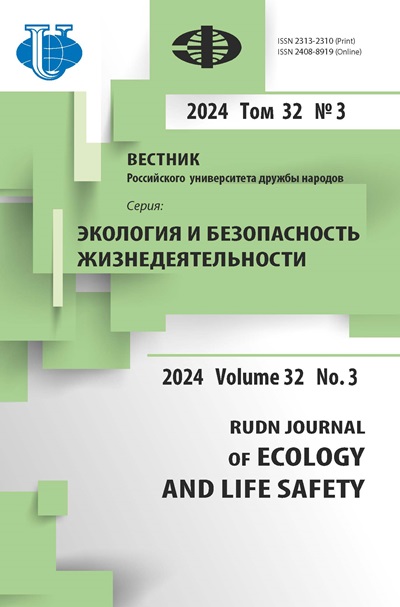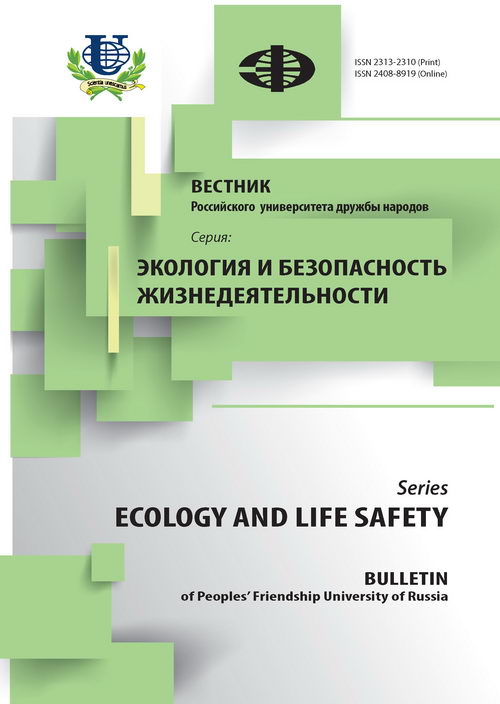Оценка состояния почв, подверженных склоновой эрозии, с использованием интегрального показателя
- Авторы: Шафигуллин Б.У.1, Галицкая П.Ю.1, Селивановская С.Ю.1
-
Учреждения:
- Казанский (Приволжский) федеральный университет
- Выпуск: № 3 (2011)
- Страницы: 70-79
- Раздел: Статьи
- URL: https://journals.rudn.ru/ecology/article/view/12312
Цитировать
Полный текст
Аннотация
Для оценки состояния почв, подверженных склоновой эрозии, предложен интегральный показатель, основанный на определении мощности гумусового горизонта, угла наклона, содержания органического вещества, уровня микробной биомассы и характеристик растительности. Показано, что его применение позволяет выявить различия в степени смытости почв с одинаковой мощностью гумусового горизонта, но расположенных на разных участках склона.
Ключевые слова
Об авторах
Булат Ульфатович Шафигуллин
Казанский (Приволжский) федеральный университетКазанский (Приволжский) федеральный университет
Полина Юрьевна Галицкая
Казанский (Приволжский) федеральный университет
Email: gpolina33@yandex.ru
Казанский (Приволжский) федеральный университет
Светлана Юрьевна Селивановская
Казанский (Приволжский) федеральный университет
Email: Svetlana.Selivanovskaya@ksu.ru
Казанский (Приволжский) федеральный университет
Список литературы
- Артемьева З.C. Органические и органо-глинистые комплексы агрогенно-деградированных почв: автореферат / Институт физико-химических и биологических проблем почвоведения РАН. 2008.
- Губанов И.А., Киселева К.В., Новиков В.С., Тихомиров В.Н. Иллюстрированный определитель растений Средней России // КМК, Институт технологических исследований, 2004. - Т. 3.
- Письмо Роскомзема от 29.07.1994 «О Методике определения размеров ущерба от деградации почв и земель.
- Носин В.А., Федорин Ю.В., Фриев Т.А. Общесоюзная инструкция по почвенным обследованиям и составлению крупномасштабных почвенных карт землепользований // Колос, 1973.
- ГОСТ 17.5.3.06-85 «Охрана природы. Земли. Требования к определению норм снятия плодородного слоя почвы при производстве земляных работ».
- ГОСТ 17.4.2.03-86 «Охрана природы. Почвы. Паспорт почв».
- ГОСТ 26213-91 «Почвы. Методы определения органического вещества».
- Anderson J., Domsch K. A physiological method for the quantitative measurement of microbial biomass in soils // Soil Biology and Biochemistry. - 1978. - V. 10. - P. 215-221.
- Andrews S., Karlen D., Mitchell J. A comparison of soil quality indexing methods for vegetable production systems in Northern California // Agriculture, Ecosystems & Environment. - 2002. - V. 90. - P. 25-45.
- Arshad M., Martin S. Identifying critical limits for soil quality indicators in agro-ecosystems // Agriculture, Ecosystems & Environment. - 2002. - V. 88. - P. 153-160.
- Bastida F., Moreno J., Hernández T., García C. Microbiological degradation index of soils in a semiarid climate // Soil Biology and Biochemistry. - 2006. - V. 38. - P. 3463-3473.
- Bastida F., Zsolnay A., Hernandez T., Garcia C. Past, present and future of soil quality indices: A biological perspective // Geoderma.- 2008. - V. 147. - P. 159-171.
- Berthelot Y., Trottier B., Robidoux P.Y. Assessment of soil quality using bioaccessibility-based models and a biomarker index // Environmental International. - 2009. - V. 35. - P. 83-90.
- Chikhaoui M., Bonn F., Bokoye A., Merzouk A. A spectral index for land degradation mapping using ASTER data: Application to a semi-arid Mediterranean catchment // International Journal of Applied Earth Observation and Geoinformation. - 2005. - V. 7. - P. 140-153.
- De Asis A.M., Omasa K. Estimation of vegetation parameter for modeling soil erosion using linear Spectral Mixture Analysis of Landsat ETM data // ISPRS Journal of Photogrammetry and Remote Sensing. - 2007. - V. 62. - Iss. 4. - P. 309-324.
- De Paz J., Sanchez J., Visconti F. Combined use of GIS and environmental indicators for assessment of chemical, physical and biological soil degradation in a Spanish Mediterranean region // Journal of Environmental Management. - 2006. - V. 79. - P. 150-162.
- Diodato N., Ceccarelli M. Multivariate indicator Kriging approach using a GIS to classify soil degradation for Mediterranean agricultural lands // Ecological Indicators. - 2004. - V. 4. - P. 177-187.
- Glover J., Reganold J., Andrews P. Systematic method for rating soil quality of conventional, organic and integrated apple orchards in Washington State // Agriculture, Ecosystems and Environment. - 2000. - V. 80. - P. 29-45.
- Gomez J., Alvarez S., Soriano M. Development of a soil degradation assessment tool for organic olive groves in southern Spain // Catena. - 2009. - V. 79. - P. 9-17.
- Kirkby M., Bissonais Y., Coulthard T., Daroussin J., McMahon M. The development of land quality indicators for soil degradation by water erosion // Agriculture, Ecosystems and Environment. - 2000. - V. 81. - P. 125-135.
- Lemenih M., Karltun E., Olsson M. Assessing soil chemical and physical property responses to deforestation and subsequent cultivation in smallholders farming system in Ethiopia // Agriculture, Ecosystems and Environment. - 2005. - V. 105. - P. 375-386.
- Liao M., Xiao X. Effect of heavy metals on substrate utilization pattern, biomass, and activity of microbial communities in a reclaimed mining wasteland of red soil area // Ecotoxicol. Environ. Saf. - 2007. - V. 66. - P. 21-223.
- Masto R., Chhonkar P., Singh D., Patra A. Soil quality response to long-term nutrient and crop management on a semi-arid Inceptisol // Agriculture, Ecosystems and Environment. - 2007. - V. 18. - P. 130-142.
- Puglisi E., Del Re A., Rao M., Gianfreda L. Development and validation of numerical indices integrating enzyme activities of soils // Soil. Biol. Biochem. - 2006. - V. 38. - P. 1673-1681.
- Ros M., Hernandez M., García C. Soil microbial activity after restoration of a semiarid soil by organic amendments // Soil Biology and Biochemistry. - 2003. - V. 35. - P. 463-469.
- Sánchez-Monedero M., Mondini C., de Nobilic M., Leitab L., Roiga A. Land application of biosolids. Soil response to different stabilization degree of the treated organic matter // Waste Management. - 2004. - V. 24. - P. 325-332.
- Selivanovskaya S.Yu., Latypova V.Z. Effects of composted sewage sludge on microbial biomass, activity and pine seedlings in nursery forest // Waste Management. - 2006. - V. 26. - P. 1253-1258.
- Sharma P., Tripathi R., Singha S. Tillage effects on soil physical properties and performance of rice-wheat-cropping system under shallow water table conditions of Tarai, Northern India // European Journal of Agronomy. - 2005. - V. 23. - P. 327-335.
- Suhadolc M., Schroll R., Gattinger A., Schloterb M., Munch J., Lestana D. Effects of modified Pb-, Zn-, and Cd-availability on the microbial communities and on the degradation of isoproturon in a heavy metal contaminated soil // Soil Biology and Biochemistry. - 2004. - V. 36. - P. 1943-1954.
- Vrieling A., de Jong S.M., Sterk G., Rodrigues S.C. Timing of erosion and satellite data: a multi-resolution approach to soil erosion risk mapping // International Journal of Applied Earth Observation and Geoinformation. - 2008. - V. 10. - Iss. 3. - P. 267-281.
- Wang G., Wente S., Gertner G.Z., Anderson A. Improvement in mapping vegetation cover factor for the universal soil loss equation by geostatistical methods with Landsat Thematic Mapper images // International Journal of Remote Sensing. - 2002. - V. 23. - Iss. 18. - P. 3649-3667.
- Zhongming W., Lees B., Feng J., Wanning L., Haijing Sh. Stratified vegetation cover index: A new way to assess vegetation impact on soil erosion // Catena. - 2010. - V. 82. - P. 87-93.
- Zhou P., Luukkanen O., Tokola T., Nieminen J. Effect of vegetation cover on soil erosion in a mountainous watershed // Catena. - 2008. - Vol. 75. - Iss. 3. - P. 319-325.
















